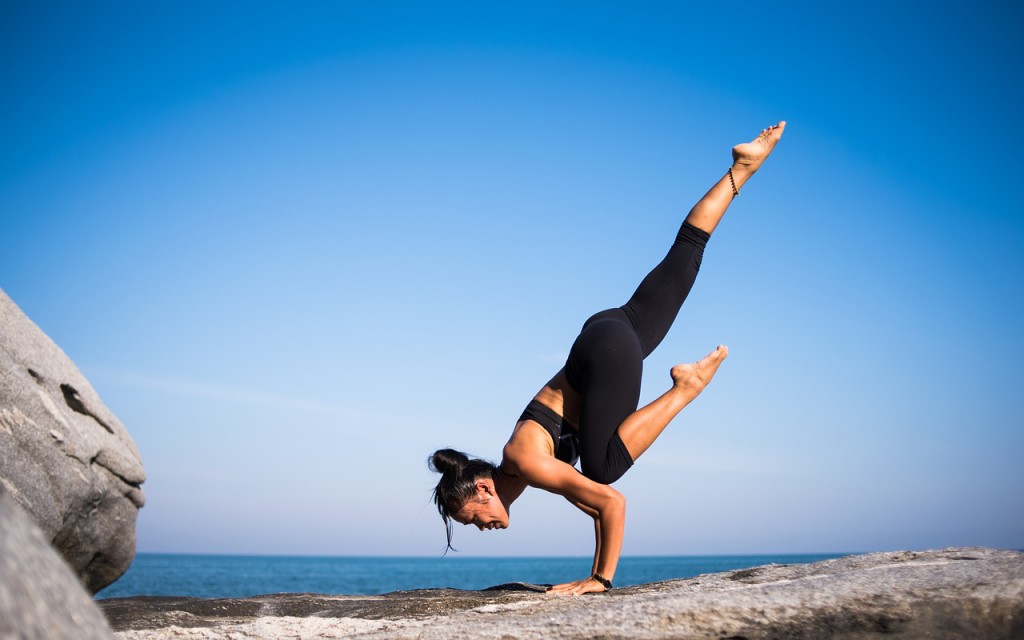Since 2007, I have had an on again, off-again affair with my yoga mat. Despite the fact that I sometimes fall completely off and focus on other forms of exercise like pilates or weight training, I eventually get drawn back to yoga for it’s ability to challenge me and keep me from going apesh#$ like the new Bey anthem when someone gets on my last proverbial nerve. Over the past ten years or so, I have tried almost every kind of yoga there is, and learned a lot about myself in the process including what doesn’t work for me.
If you are interested in yoga, keep in mind that there are many types of yoga to choose from: gentle or restorative yoga, hot yoga, vinyasa yoga, Bikram yoga, hatha yoga, ashtanga, Iyengar and more. Once merely a spiritual practice in ancient India, yoga and all of its forms are here to stay in world-at-large. Whether you choose to practice in a hot room, in your bedroom, or in a quiet studio, there are clear benefits to incorporating yoga into your daily or weekly routine and plenty of options. Finding what type of yoga works for you may be easier said than done. Below is a brief summary of various types, along with some of my personal (hopefully helpful)commentary, to help give you an idea of where to start to begin your yoga practice.
Restorative or Gentle yoga is appropriate for older adults, or those with injuries or very low flexibility who want a much gentler practice that is less of a rigorous workout. Restorative or gentle yoga can also be a great practice for anyone looking to calm the nerves as it primarily focuses on encouraging relaxation and calming the mind. In this practice you will have fewer postures, and the support of props to help you to ease at your own pace into postures and breathe deeply. If you are A) a control freak, B) have trouble sitting still for long periods, or C) love bootcamp workouts, you may want to pass on restorative yoga unless you are nursing an injury and need a change of pace.
Bikram Yoga was founded in 1974 by Bikram Choudhury and classes incorporate specialized breath exercises and the same series of twenty six postures in a room heated at 95–108 °F. The room is exceptionally hot, so if you cannot handle high temperatures this is not the class for you. Taking Bikram requires that you adequately hydrate before and after class to avoid dizzy spells. If you thrive on repetition and like the idea of knowing what comes next, and love a good trip to the sauna, this class may be for you. I had about a good solid year where I loved bikram, but the monotony of the repetitive poses finally led me elsewhere. You know it’s time to try something else if you find yourself staring at the clock, wishing it was already over!
Hot yoga is practiced in a heated room, with the temperature set anywhere from 80-105 °F. Some versions of hot yoga are practiced in the hatha style of yoga, while some studios teach the vinyasa flow style of yoga in a heated room. This type of yoga, is practice is studios that are gym-like such as Core Power Yoga. If you need to sweat, and prefer a practice that is more of a workout, hot yoga may be just right for you. In some studios, classes are also offered that pair hot yoga classes with weights to increase muscle tone. Remember that type A person who loves boot camp workouts? This is all you boo. Hot yoga happens to be my favorite type of yoga, because I do prefer the workout with none of the fluff. All those with me, I’ll see you on the mat soon!
Hatha yoga is a broad and generic term that refers to any type of yoga that teaches physical postures. In a hatha yoga class you will most likely get an introduction to basic yoga postures and pranayama (breathing exercises). Are you someone who wants to get it right? Starting off with a basic hatha class can help you figure out your proper alignment and understand yoga basics before branching out.
Iyengar yoga classes will be loved by anyone who pays great attention to detail. If you need to work slower, or have any prominent injuries this may also be a great practice for you. This practice which was founded by B.K.S. Iyengar, focuses on precision and alignment while controlling the breath. Poses are held for longer periods of time, and small adjustments are made generally with the help of props to make it easier and safer to go deeper. If you are someone who rolls your eyes at the people flailing around within improper form while lifting weights at the gym, you’ll probably take to Iyengar like a fish to water.
Prenatal Yoga is for expecting moms and can be practiced by pregnant women in all trimesters of pregnancy. The exercises and postures in prenatal yoga can be beneficial preparation for labor because they include pelvic floor work and breathing exercises. I’ve had a few preggo friends who practiced prenatal religiously before delivery and said that it made a huge difference!
Ashtanga is for advanced practitioners of yoga and not suitable for beginners. If you are someone who has been practicing for years and need a new challenge, ashtanga may be worth a try. It involves a very physically demanding series of movements, including sun salutations, floor, and standing postures. This is one of the few types of yoga I have never tried. For those of you who already are yoga gangsters, let me know what you think.
Yin practice involves holding poses for 45 seconds to up to 2 minutes which almost becomes a form of meditation. Although it may seem easy at face value, some yin practices can be very challenging. These classes can be great for beginners as they also offer an opportunity to slow down and focus on alignment. If you are the type who loves intensity over speed, yin may be the practice for you. I can personally attest to the fact that yin can be harder than it looks. I took my first yin class at a yoga festival a few years back and found myself sore for three days afterwards.
Kundalini practice is more of a deep spiritual practice that is not for the faint of heart and involves chanting, postures, breathing exercises, and meditation. The purpose of kundalini yoga is to activate the kundalini energy trapped at the base of your spine, which through regular practice eventually rises up to meet the third eye. During kundalini classes, some practitioners report a release of grief, anger, or other emotional energies. In my own time practicing kundalini, I experienced yogis wailing, crying, or screaming during a class. If you don’t shy away from emotional intensity, and are looking for a spiritual awakening, kundalini may be your speed. For the rest of us, pairing meditation with another form of yoga practice may be all we need.
Vinyasa which is a style of yoga that was adapted from ashtanga in the 1980s can be suitable for beginners or more advanced practitioners of yoga who want a workout. Usually consisting of a series of postures practiced in an athletic non-stop flow of movement and breathing, vinyasa will lead you to break out in a sweat. If you love intense workouts (raises hand), and want a practice that feels like exercise, a vinyasa flow practice in a heated or non-heated room may be ideal for you.
References:
(2017). YIN YOGA. Place of publication not identified: DK Publishing.
Bikram Yoga. (2018, July 10). Retrieved July 15, 2018, from https://en.wikipedia.org/wiki/Bikram_Yoga
Iyengar, B. K. (2015). Light on yoga: The definitive guide to Yoga practice. London: Harper Thorsons.
McGee, K. (2018, March 02). Types Of Yoga – Breakdown Of 11 Major Types. Retrieved July 15, 2018, from https://www.mindbodygreen.com/articles/the-11-major-types-of-yoga-explained-simply






